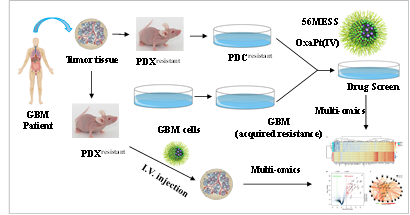New platinum-based nano-drugs can combat glioblastoma drug resistance on a patient-derived mouse model
Yongheng Wang, Yuhang Jiang, Dengshuai Wei, Priya Singh, Yingjie Yu, Teresa Lee, Lingpu Zhang, Hanna K. Mandl, Alexandra S. Piotrowski-Daspit, Xinyuan Chen, Fan Li, Xing Li, Yiyu Cheng, Alexander Josowitz, Fan Yang, Yao Zhao, Fuyi Wang, Zhenwen Zhao, Anita Huttner, Ranjit S. Bindra, Haihua Xiao & W. Mark Saltzman
Nat Biomed Eng 10.1038/s41551-021-00728-7
Glioblastoma (GBM) is the most common and deadly brain tumor in adults, with a five-year survival rate of less than 10 percent. Currently, temozolomide (TMZ) is the first-line anticancer drug for GMB, but its drug resistance has long been a problem. It is known that acquired mismatch repair defects and overexpression of O6-methylguanine-DNA-methyltransferase (MGMT) are associated with TMZ resistance. Therefore, it is crucial to find new treatment options and drugs other than TMZ with different action mechanisms to address this problem.
In a recent study published in Nature Biomedical Engineering, a research group led by Professor Xiao Haihua at the Institute of Chemistry of the Chinese Academy of Sciences (ICCAS) and Professor W. Mark Saltzman at the School of Engineering and Applied Sciences at Yale University developed a platinum-based nanodrug to tackle TMZ resistance.
The researchers first designed a reduction-responsive biodegradable polymer to encapsulate a platinum(IV) prodrug of oxaliplatin and a platinum(II) DNA intercalator 56MESS separately to form two nanoparticles. Secondly, the researchers established a TMZ-resistant patient-derived GMB primary cell line (GBM-PDCResistant) and an acquired drug-resistant transgenic engineered GMB cell line (GBM-TransgenicResistant) to screen the aforementioned platinum-based nanoparticles in vitro. They found that both of them can reverse TMZ resistance. Thirdly, the researchers further developed a TMZ-resistant patient-derived xenograft mouse model of GMB (GBM-PDXResistant) in vivo. Subsequently, with the help of advanced convection-enhanced delivery technology (CED), these nanoparticles were able to directly deliver drugs to the target brain area for bypassing the blood-brain barrier in mice. They found that nanoparticles loaded with the DNA intercalator 56MESS can work better to inhibit the growth of drug-resistant GMB tumors and prolong their survival rate. Finally, through RNA-sequencing, the researchers found that the signal transduction and metabolic pathways altered by 56MESS-based nanoparticles are quite different from those of TMZ, confirming their unique mechanism of action.

https://www.nature.com/articles/s41551-021-00728-7
